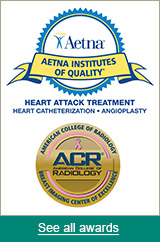History
Sharon Regional Health System has played a major role in the community since its inception more than 100 years ago. Today, Sharon Regional is proud to have developed a multifaceted array of medical, health and community services usually found only at institutions in much larger cities. With more than 1,750 employees, Sharon Regional is Mercer County's largest employer.
Ground breaking for Sharon Regional Health System
The hospital was created to meet the demands of community healthcare problems, some of which were caused by inadequate sanitation. Like most other towns in the late 1800s, Sharon was starting to build a sanitation system. Most of the local diseases stemmed from that source of bacteria as well as a stagnant canal bed that had been closed for two years and cut through the center of the Shenango Valley.
Diphtheria was prevalent and smallpox struck frequently. During the cold, damp winters, pneumonia and pleurisy claimed many lives. This was despite a treatment of blue clay and glycerin smeared on linen and applied to the patient's chest. Those who lost weight, ran a fever and became listless were diagnosed with typhoid; no one knew that contaminated milk was the cause. Those with tuberculosis were not yet isolated and, consequently, many families died from exposure.
The community also had many surgical needs, frequently from industrial accidents and some from cancer. Even before a hospital was planned, Dr. Elisha Griswold, a former Civil War surgeon and one of the hospital's founding members, performed both types of surgeries. The need for something more than a surgical arena of kitchen tables under lamplight was the obvious incentive for Dr. Griswold to open the Valley's first hospital in Sharon on Silver Street between Shenango and Vine avenues.
The community helped found the facility that later became Sharon Regional. By May 8, 1893, Sharon's population was 7,000 when the foundation for the Sharon and Sharpsville Charitable Hospital was incorporated. Co-founders of the hospital were Dr. Griswold, Dr. Charles Hoyt, Dr. Joseph H. Reed and Dr. Salem Heilman along with William Wallis, John C. Owsley, Joseph Forker, Earl A. Wheeler, John Bert and Luther A. Burrell. The original hospital building cost less than $40,000, with 80 percent funded by the community and 20 percent by the state.
On May 5, 1896, three days before the hospital was scheduled to open, the board changed the name to Christian H. Buhl Hospital. Buhl, a Detroit native, was credited with investing much in the Shenango Valley. All the hospital's linens were quickly marked accordingly before the grand opening that featured Pennsylvania Governor Hastings.
Christian H. Buhl Hospital Nurses
The Sharon Herald described the new facility as "a cracker box of red brick." There was no basement initially under the only operating room, in the west front annex of the three-story, 18-bed building. Doctors described working the operating room as standing on a cube of ice. Patients paid $5 for their room.
Among those early community doctors who used the hospital were Dr. Griswold, Dr. Heilman, Dr. Reed, Dr. Hoyt, all of Sharon; Dr. Livingston and Dr. Hillier, both of West Middlesex; and Dr. Twitmyer, of Sharpsville. The Sharon Herald also indicates that the Valley's first female doctor, Phoebe Brooks, was not at first welcomed in the Women's Ward.
By 1901, an addition was completed to the rear of the building. Two 12-patient wards were added by 1903. The wards called for eight nurses to be on duty at one time. There were 12 private rooms, two large and two small wards, but crowding sometimes forced patients into sun parlors.
Nurses lived on the third floor and worked 10-12 hour shifts before taking night classes from the medical staff. Nurses initially earned $8 a month and furnished their own books and uniforms. A home for the nurses was built in 1917 with funds from the estate of Peter L. Kimberly.
By 1927, the 108-bed hospital offered the community services in general medicine, general surgery, diabetes, gynecology and obstetrics, orthopedics, otolaryngology, pediatrics and syphilis. Not admitted to the hospital were those with contagious, mental and chronic diseases. Those with contagious diseases were taken to a house on the edge of town known as the isolation ward. Daily rates were $4-$7 private and $3.50 ward. The average daily number of patients was 58. There were two doctors on the resident staff, 21 on the attending staff and 20 on the courtesy staff. The Hospital's support staff was 33.
During the four years preceding 1943, the hospital's 50th anniversary, $490,000 was spent to better equip the facility for increased demands from war workers, soldiers and their families. More than a dozen physicians served in the military including Capt. George Wassell, flight surgeon and captain in the Army Air Forces who was killed in a 1942 airplane crash in England.
Another addition was created in 1939 with the help of $145,314 raised from the community. The third floor was rebuilt and the fourth floor was replaced with a new one that housed the Maternity Department. In 1942, 1,438 babies were born, which was an 18 percent increase from the previous year.
Christian H. Buhl Hospital
In 1949, the name of Christian H. Buhl Hospital was changed but never formally adopted to Shenango Valley General Hospital. Hugh J. Garvey, board president, said many people thought the name Buhl meant the hospital was endowed rather than a community hospital. Shortly before the announcement, the board decided the call the institution Sharon General Hospital. That year the average daily census was 188 and the cost per patient day was $12.50.
In 1958, the $1.25 million North addition was completed. In 1963 a psychiatric unit was added. An intensive/coronary care opened in 1968 and increased the hospital's bed capacity to 292.
A $17 million expansion program started in 1979 and involved the construction of a 6-story, 111,179 square-foot addition to the hospital's west side. The program also included the renovation of 77,500 square feet in the original building. The modernization project was completed six years later.
The 1980s brought continued expansion throughout the region with new and innovative health services. Corporate Health Services, a comprehensive occupational medicine program, started in 1986 to better meet the needs of the corporate community.
In 1988, the hospital added Magnetic Resonance Imaging, a 40-bed Skilled Care Center and renovated its 4th floor to relocate an expanded Behavioral Health Center. May 15, 1990 brought a new name from the board of directors: Sharon General Hospital became Sharon Regional Health System.
The change more accurately described the growth in healthcare services and technological capabilities offered by the hospital and its numerous centers throughout the region.
New programs opened in 1990 included a 19-bed Inpatient Physical Medicine and Rehabilitation Unit, 12-bed Inpatient Child/Adolescent Psychiatric Unit, Speech Therapy Department, Pain Management Program and expanded Occupational Therapy services.
In 1991 Sharon Regional established its Heart Center that brought cardiac diagnostic, treatment and rehabilitative services into one newly remodeled facility on the 2nd floor of the hospital. This Heart Center continued to experience rapid growth throughout the decade. The development of an $8 million Heart Institute at Sharon Regional was announced in 1999. Opened in the summer of 2000, The Heart and Vascular Institute brings open heart surgery capabilities along with angioplasty, stenting and a second cardiac catheterization lab to Sharon Regional.
An Emergency Care Center, Women's Center, Diabetes Center, Hermitage Diagnostic & Imaging Center, freestanding Cancer Care Center, Advanced Wound Recovery Center, Hubbard Diagnostic and Specialty Center, Rehab Center, Neshannock Disgnostic & Specialty Center, and expanded Behavioral Health Services make Sharon Regional the area's leader in delivery of health care services.
In 2013 the Sharon Regional board of directors completed a year-long process to determine if the best interests of the community would be served by Sharon Regional remaining independent or pursuing some type of strategic partnership. After thoughtful deliberation and a thorough and competitive evaluation of several partnership options, the board chose Community Health Systems (CHS), based in Franklin, Tennessee, one of the largest and most successful health care organizations in the nation.
On April 1, 2014 the hospital of Sharon Regional along with the outpatient clinics and other ancillary facilities operated as part of Sharon Regional Health System became affiliates of Community Health Systems. The terms of the transaction included the investment of a minimum of $75 million within the next five years to advance facilities, services, and medical technology; a continuation and growth of essential services, including medical/surgical, critical care, open heart and vascular surgery, emergency services, and obstetrics; a continuation of charity care policies to help serve indigent patients and participation in the Medicare and Medicaid programs; the appointment of a local board of trustees comprised of community leaders and members of the hospital’s medical staff; and several other commitments.
The affiliation with CHS will support healthcare delivery in the region with the infusion of new resources allowing Sharon Regional to continue focusing on growth and providing the most needed services for the residents of northwestern Pennsylvania and northeastern Ohio.




